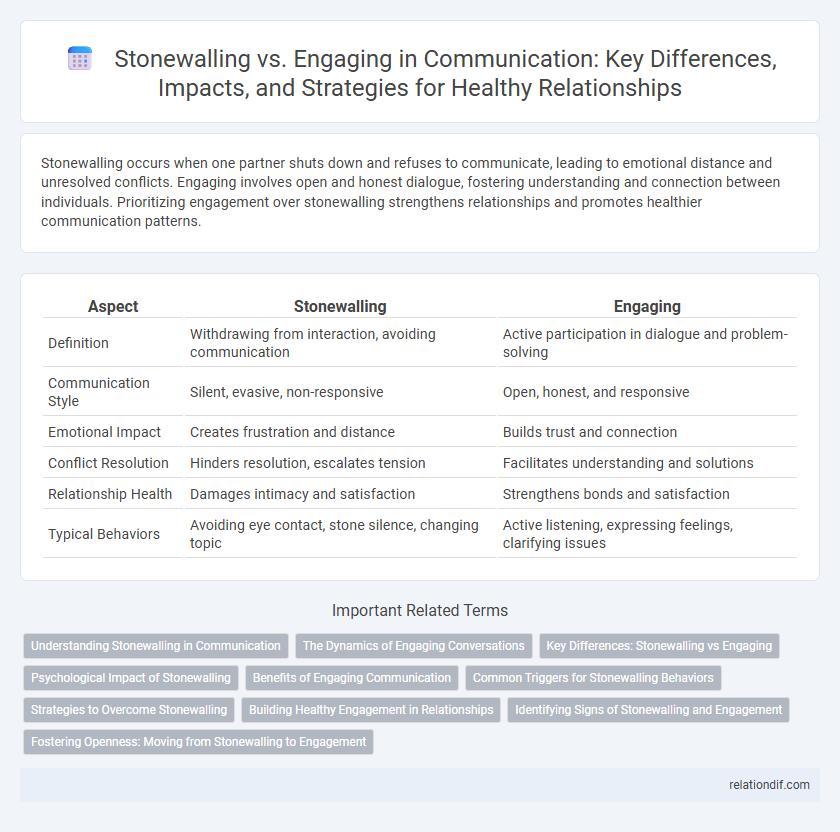Stonewalling occurs when one partner shuts down and refuses to communicate, leading to emotional distance and unresolved conflicts. Engaging involves open and honest dialogue, fostering understanding and connection between individuals. Prioritizing engagement over stonewalling strengthens relationships and promotes healthier communication patterns.
Table of Comparison
| Aspect | Stonewalling | Engaging |
|---|---|---|
| Definition | Withdrawing from interaction, avoiding communication | Active participation in dialogue and problem-solving |
| Communication Style | Silent, evasive, non-responsive | Open, honest, and responsive |
| Emotional Impact | Creates frustration and distance | Builds trust and connection |
| Conflict Resolution | Hinders resolution, escalates tension | Facilitates understanding and solutions |
| Relationship Health | Damages intimacy and satisfaction | Strengthens bonds and satisfaction |
| Typical Behaviors | Avoiding eye contact, stone silence, changing topic | Active listening, expressing feelings, clarifying issues |
Understanding Stonewalling in Communication
Stonewalling in communication occurs when one person withdraws or shuts down, refusing to respond or engage in dialogue, often as a defense mechanism against conflict or emotional overwhelm. This behavior disrupts effective communication by blocking emotional connection and impeding problem resolution, leading to frustration and misunderstanding between parties. Recognizing stonewalling early allows individuals to address underlying issues, fostering more open and constructive interactions.
The Dynamics of Engaging Conversations
Engaging conversations foster active listening, emotional validation, and reciprocal sharing, which prevent the isolation often caused by stonewalling. Stonewalling, marked by withdrawal and silence, disrupts communication flow and escalates conflict, whereas engaging promotes collaboration and understanding. Effective communication dynamics rely on mutual responsiveness, creating a safe space for openness and trust to flourish.
Key Differences: Stonewalling vs Engaging
Stonewalling involves withdrawal and refusal to communicate, often leading to emotional disconnection and unresolved conflicts. Engaging promotes open dialogue, active listening, and mutual understanding, fostering stronger relationships and effective conflict resolution. The key difference lies in stonewalling's avoidance of interaction versus engaging's commitment to constructive communication.
Psychological Impact of Stonewalling
Stonewalling during communication triggers significant psychological distress, often leading to feelings of rejection, invisibility, and frustration in the recipient. This withdrawal behavior disrupts emotional connection and escalates conflict by fostering misunderstandings and emotional withdrawal. Persistent stonewalling can contribute to increased anxiety, depression, and deterioration in relationship satisfaction.
Benefits of Engaging Communication
Engaging communication fosters trust, enhances mutual understanding, and strengthens relationships by encouraging open dialogue and active listening. It reduces conflicts and misunderstandings by addressing concerns directly and empathetically. Consistent engagement promotes emotional connection and collaboration, leading to more effective problem-solving and positive outcomes.
Common Triggers for Stonewalling Behaviors
Common triggers for stonewalling behaviors include emotional overwhelm, feeling attacked during conflict, and a perceived lack of safety in communication. These triggers often lead individuals to withdraw, shut down, or avoid interaction as a protective mechanism. Recognizing signs such as increased silence, minimal eye contact, or physical distancing can help address stonewalling early in conversations.
Strategies to Overcome Stonewalling
Overcoming stonewalling in communication requires deliberate strategies such as practicing active listening, expressing emotions calmly, and creating a safe space for open dialogue. Techniques like taking short breaks to cool down and using "I" statements help reduce defensiveness and promote engagement. Implementing these methods fosters trust and prevents communication breakdowns in relationships.
Building Healthy Engagement in Relationships
Stonewalling in communication often leads to emotional disconnection and unresolved conflict, while engaging fosters openness and mutual understanding. Building healthy engagement requires active listening, empathetic responses, and consistent feedback to create trust and deepen connection. Couples who prioritize engagement techniques experience stronger emotional bonds and more effective conflict resolution.
Identifying Signs of Stonewalling and Engagement
Stonewalling in communication manifests through signs such as avoiding eye contact, giving monosyllabic responses, and physically withdrawing from conversations, indicating emotional shutdown. Engagement is identified by active listening cues, open body language, and responsive dialogue, fostering mutual understanding and connection. Recognizing these behaviors helps improve conflict resolution and emotional intimacy in relationships.
Fostering Openness: Moving from Stonewalling to Engagement
Fostering openness in communication requires shifting from stonewalling, characterized by emotional withdrawal and silence, to active engagement involving attentive listening and honest expression. Studies reveal that couples who replace stonewalling with empathetic dialogue experience increased trust and conflict resolution efficacy. Techniques such as reflective listening and vulnerability sharing significantly enhance connection and mutual understanding.
Stonewalling vs Engaging Infographic

 relationdif.com
relationdif.com